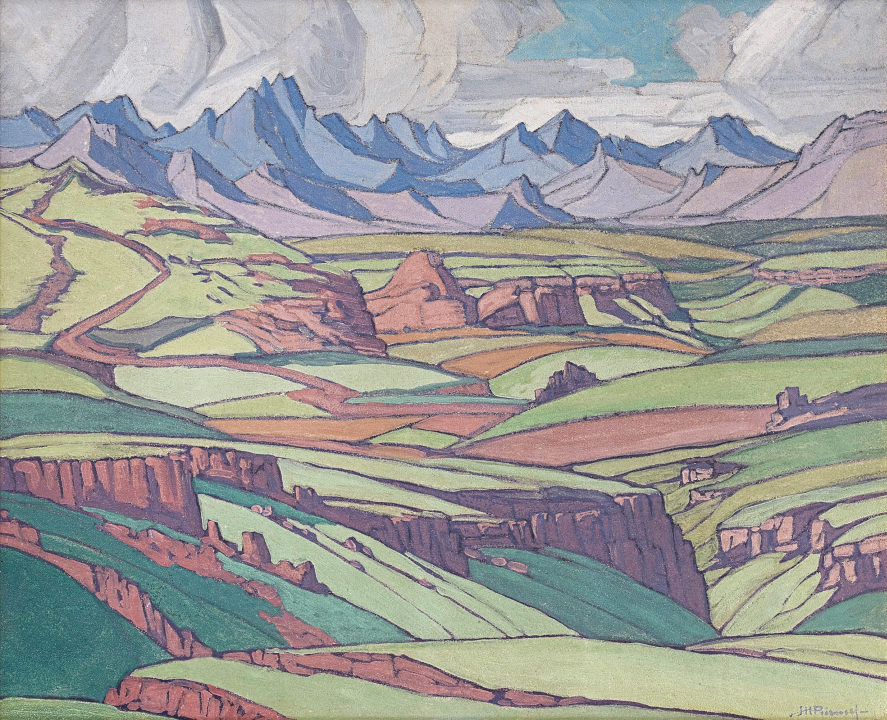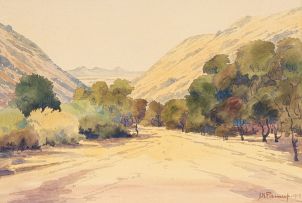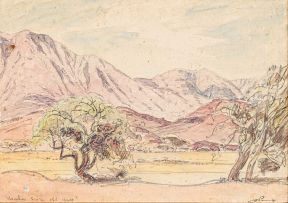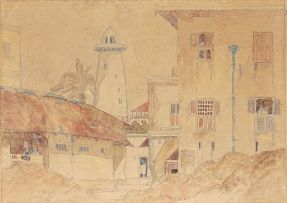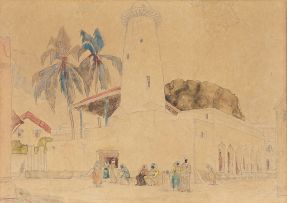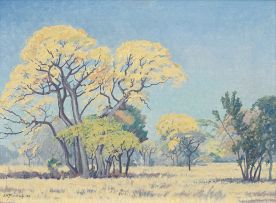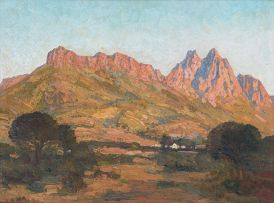Important South African & International Art, Decorative Arts & Jewellery
Live Auction, 16 March 2015
Important South African and International Art Evening Sale
Incl. Buyer's Premium & VAT
About this Item
signed; inscribed on a label affixed to the reverse as follows:
In Desember 1929 toe die F. A. K. in Bloemfontein gestig is, het Pierneef 'n uitstalling in die saal van die Nasionale Museum gebou. Tant Mabel Jansen het die uitstalling geopen. Sy was by ons tuis. Die vorige middag het ek met hom saam gegaan om die skilderye te besigtig. Ek soek toe twee skilderye vit ons uit en koop hulle die volgende oggend by die opening - die grote wat Heloise het vir £25 en hierdie een vir £20. Ons het daardie maand nie ons winkelrekening betaal nie.
signed S Henri Pellissier, Swellendam, 30/12/1966
Notes
The mountain landscapes near Ficksburg, in the eastern Free State, recur as subjects in JH Pierneef's work from his important middle period (1925-35). His painterly descriptions of especially the Maloti Mountains (also spelled Maluti) encompass a range of styles, from the impressionistically descriptive to the formally experimental. Evident throughout, though, is Pierneef's fidelity to place and architectonic approach to composing space ("a mathematical precision of line and colour," as he put it in a 1926 interview).1 This painting, with its receding foreground of jaggedly tiled greens and browns, predates his monumental study of the same range for his Station Panels series, unveiled in Johannesburg in 1932. Similar to that better-known work, which features theatrical clouds and mountains resembling ground molars, the scene is descriptive of a verifiable landscape. Locatable as it is, the landscape bears an unmistakable Pierneef imprimatur.
Pierneef's quest to define an authentic personal style was hard won and informed by larger forces. The artist was 23 when the Union of South Africa was founded as a dominion of the British Empire in 1910. This watershed event, which united disparate groupings of peoples and political territories under a single flag, ushered in a period of nationalist organisation and grassroots activism. Pierneef was an active protagonist, initially as a member of The Individualists, a group of progressive artists from Pretoria, and latterly as a revered national artist whose landscapes mapped the totality of the mature union. The provenance of this undated work sheds important light on the key role of early patrons in helping Pierneef achieve his vision of an authentically South African art in the newly unified state.
In December 1929, over 300 Afrikaner figureheads - including political leaders C.R. Swart and D.F. Malan - met in Bloemfontein to discuss ways to coordinate the activities of various cultural organisations. The meeting culminated in the founding of the Federasie van Afrikaanse Kultuurvereniginge (FAK), an umbrella organization for Afrikaner cultural groups. To coincide with this meeting, Martin du Toit, editor of the recently established magazine Die Nuwe Brandwag, organised an exhibition at the National Museum featuring work by Pierneef, Maggie Laubser, Anton van Wouw, Gerard Moerdyk and Gordon Leith.2 Martha Mabel Jansen, an influential cultural leader and well-known art collector, opened the exhibition; it was here that her brother, Samuel Henri Pellissier, acquired this painting.
The grandson of a French missionary who settled in Bethulie, Pellissier is best remembered for his work establishing the Volkspele movement in 1914. An educator by profession, who was later to be appointed Director of Education for the Orange Free State and Vice-Chancellor of UNISA, he already knew the artist personally when he acquired this work. The two met in 1922 when Pierneef was commissioned to decorate the school hall in Ficksburg. Pellissier was principal of the school and offered Pierneef lodgings during the month-long production of his eight murals. Pierneef's first public commission comprised interpretive renderings of San rock art he based on documentation produced by early researchers, notably Helen Tongue and George Stow.3 Despite his second-hand encounter with San art, Pierneef held the work in high regard and described it in a 1916 letter as an "ideal basis" (idiale grondslag) for a new national art.4 Pierneef communicated this message widely, including during a lecture in Bloemfontein in 1917. Significantly, Pierneef stayed with Reenen J. van Reenen, a senior public works official, during this visit. And it was Van Reenen, an amateur rock art enthusiast who frequently hiked the Malutis with Pellissier, that later put the artist's name forward to decorate the ambitious principal's school hall in Ficksburg.
1 Pretorius, Estelle (1990) 'Biography of Jacob Hendrik Pierneef', in J.H. Pierneef: His Life and his Work, Cape Town: Perskor. Page 69.
2 Van Eeden, Jeanne (2008), 'Collecting South African Art in the 1930s: The Role of Martin du Toit' in Historia, Vol. 53(1): May. Page 171.
3 Duffey, Alexander (2002) 'Pierneef and San rock art', in De Arte, Vol. 66: September. Page 23.
4 Ibid. Page 23.
Provenance
Purchased by Dr S H Pellissier from an exhibition in 1929 at the National Museum, Bloemfontein
Purchased at an auction in Johannesburg in 1996 by the current owner
View all Jacob Hendrik Pierneef lots for sale in this auction
